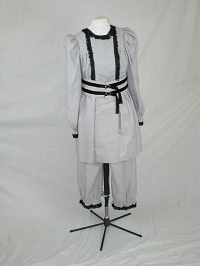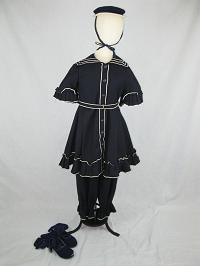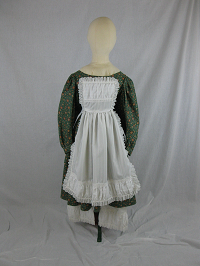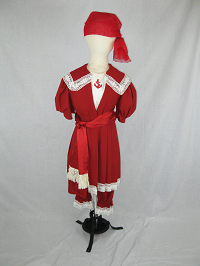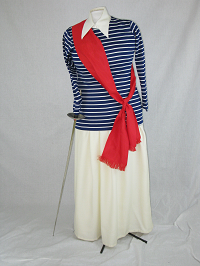
- Details
- Category: 19th century
- Hits: 2562
1890s
Women continued to make their greatest strides by becoming active. The ultra rich built homes of the 1890s with swimming pools inside. Schools added swimming and exercise to their programs. Blue cotton tunic and bloomers compose this outfit for the gymnasium. Social customs allowed young ladies to be less restricted when taking their exercises. Young ladies of distinction boarded or went daily to seminaries such as Highland Hall in Hollidaysburg, PA. French designers gave their stamp of approval to bloomers for cycling, bathing, and gymnasium outfits. Special corsets for sports and exercising were constructed with less boning, and were sometimes replaced by a wide belt. These sometimes were made of stiff leather and gave support when not wearing the corset. Fringe and trimming still abound even on such a utilitarian item of clothing. The leg was covered with silk or cotton stockings. Some in checks, stripes or embroidered. Tied on slippers protected the feet. Bowling-pin shaped “Indian Clubs,” or meels, weighed two to 24 pounds each and were popular for toning muscles and building strength. Ladies used lighter weight clubs but did the same exercises as the men.
Click photo for detailed view.
- Details
- Category: 19th century
- Hits: 2811
1873
Dress for bathing began around the middle of the 19th century. By the late 1860s bathing dress was featured in the magazines every summer, but concerned parents kept their young daughters away from the public beaches because they were not segregated by sex. Some watering places had separate beach hours or locations for men and women, but gentlemen looked on at the women’s bathing area and women went to the men’s beach to gaze. This bathing outfit typical of 1876 is a combination dress and drawers. Navy blue wool serge was the most popular with red as a close second. Buttoning down the front, the tunic is worn with a belt. The neck is closed at the throat to prevent tanning, and it has a deep sailor collar trimmed with three rows of middy braid. Gathered just above the ankles, the trousers, are also trimmed with braid. The buttoned waist had safety ties, just in case you popped a button. No costume was complete without a complement of accessories. This hat and shoes might be out of place today, but in 1876 both were necessary for a trip to the seaside. The small sailor hat of straw and puffed wool is tied under the chin to keep it on in the sea breezes. The bathing shoes are also blue wool sewn to leather soles and buttoned up the legs. This suit made swimming a dangerous activity, since wool tends to become heavier when wet - about five times heavier. There is a mention of an inflatable preserver, but what it looked like is unknown.
Click photo for detailed views.
- Details
- Category: 19th century
- Hits: 2629
1830s
The print of this floral pattern with its harsh contrasts is fairly typical of the 1830s. The low wide necklines popular with the women were extended to the children. Young women and girls wore aprons to protect their clothing. Everyday aprons were typically of dark colors, but for special occasions extra fancy aprons with ruched borders and lace dressed up the outfit. The padded hems of the 1820s have been moved to the undergarments. Several petticoats, some with thick piping, hold out the billowing skirts. The “gigot” sleeves, which were popular from 1824 to 1836, are set into a small high armhole. These large, fully gathered, sleeves are not the maximum width. Also left out are the pillows, or wicker, formerly used to extend them even farther.
As children's clothing took on its own identity and children were no longer dressed as "little adults," new fashions appeared especially for them. Many portraits show children and young ladies with bloomers, pantelettes and ruffles covering the legs between the bottom of the shorter skirts and the top of the shoes. The clergy thought trousers were evil and too masculine for the Victorian women, but children had more freedom and could wear them.
The applied decorations popular in the 1820s became passé and were replaced by brightly patterned materials.
Click photo for detailed views.
- Details
- Category: 19th century
- Hits: 2610
1890s
Can you imagine what the beaches looked like in the 1890s with bathing beauties attired in two-piece red wool bathing suits like this?. By the 1890s the long full drawers deemed appropriate earlier have been shortened into bloomers. The bloomers and top are completely lined. Many women went to the beach but few of them actually swam. The suits were made of non-clinging fabric such as wool flannel or mohair. The beaches were segregated by sex, and times were posted for men and women to swim separately. Nautical motif, a sash, hair covering and shoes were all part of the ensemble. The large puff sleeves have the fullness in the lower edge, adjusted with elastic. White lace frames the collar and also emphasizes the wide shoulder line popular in the 1890s. Hair was tied up to keep it from drying out in the sun. Little swimming was actually done, and no tanning, since a milky white complexion was preferred at this time. The sash fashionable in the everyday wear of the mid-1890s even appeared on the bathing suit. For those determined to “take the waters,” “bathing machines,” covered wagons outfitted with ropes and a couple of sturdy women for assistance, helped bathers to get out of the water wearing the heavy wet woolens. The weight of wool increases by as much as five times when wet. The lady was helped down the steps into the water by two study women who thought it their duty to see she got at least one good mouthful of water - for health reasons.
Click photo for detailed view.
- Details
- Category: 19th century
- Hits: 2973
1887
The 1880s brought the return to the bustle. The knees had been freed by this time, and the trains for day disappeared for easier walking, but the weight of the costumes and the structures needed to support the huge rear extension added little to increase mobility. In the 1880s, many of the fabrics were upholstery-like, made even heavier with beading, fringes, braids, and furs. Some dresses alone weighed over ten pounds. Yet it was during this period women pushed further into the area of sports, invading some that had wholly been the domain of men, such as yachting and fencing.
In 1887 a number of ladies who had witnessed the grace and dexterity of their male friends thought they also would benefit by such exercise. In fencing, the ladies wore an ordinary tennis skirt, reproduced here in white wool and pleated at the waist. No corset was worn, which was quite a departure from the norm. Drawings in Harper's Bazaar for 1889 indicate how deforming the corsets were. Fashion dictated a 16-inch waist. Some women had their floating ribs surgically removed to achieve this.
An easy fitting blouse and jersey were worn over the skirt. Here we see a nautical flavor with a blue and white striped jersey, white blouse and red silk tie. The purpose of the sash has not yet been determined but all the ladies pictured were wearing them. Flat soled shoes and an antique rapier complete the picture. A wire mask protected the face, a padded buckskin plastron was worn over the chest and a buckskin gauntlet saved the hand from any chance scratches or thrusts.
Click photo for detailed views.
Page 8 of 13
